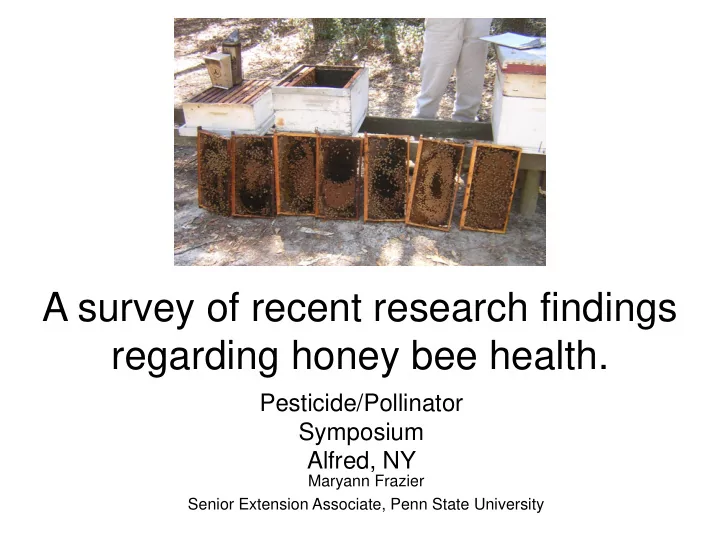

A survey of recent research findings regarding honey bee health. Pesticide/Pollinator Symposium Alfred, NY Maryann Frazier Senior Extension Associate, Penn State University
North America Pollinators National Academies of Science Status of Pollinators in North America 2007 Pollinators are in decline http://www.nap.edu/catalog/11761.html
European Pollinators J. C. Biesmeijer, S. P. M. Roberts, M. Reemer, R. Ohlemler, M. Edwards, T. Peeters, A. P. Schaffers, S. G. Potts, R. Kleukers, C. D. Thomas, J. Settele, and W. E. Kunin 21 July 2006 Science 313 (5785), 351.[DOI:10.1126/science.1127863] Parallel declines in pollinators and insect-pollinated plants in Britain and the Netherlands www.sciencemag.org
Honey Bee Colony Losses 2007 = 31% 2008 = 35.8% 2009 = 29% 2010 = 33.8% AIA and USDA/ARS
Colony Collapse Disorder [CDD] • Adult bee population suddenly gone or reduced to small cluster w/o dead bees – Over a few weeks, or a few days – In locations where bees are active (FL CA in winter) Jeff Pettis/USDA Jeff Pettis/USDA
What have we learned?
Nosema disease New species ? Nosema apis Nosema ceranae What Impact? Nosema spores
High level of pesticide exposure Acephate Chlorothalonil Fenbuconazole Pendimethalin Acetamiprid Chlorpyrifos Fenhexamid Permethrin Aldicarb sulfone Coumaphos Fenpropath rin Phosmet Aldicarb sulfoxide Coumaphos -Chlorferone Fluva linate Pyraclostrobin Allethrin Coumaphos oxon Heptac hlor Pyrethrins Amicarbazone Cyfluthrin Hexachlorobenzene Pyrimethanil Amitraz (2,4-DMA) Cyhalothrin (total) Imidacloprid Quintozene (PCNB) Amitraz (2,4-DMPF) Cypermethrin Imidacloprid olefin Sethoxydim Atrazine Cyprodi nil Imidacloprid, 5-hydroxy Simazine Azinophos-methyl Deltamethrin Indoxacarb Tebuconazole Azoxystrobin Diazinon Malathion Tebufenozide Bendiocarb Dicofol Methidathion Tebuthiuron Bifenthrin Difenoconazole Methoxyfeno zide Tetramethrin Boscalid Diflubenzuron Methyl parathion Thiabendazole Captan Dimethomorph Metolachlor Thiacloprid Carbaryl Diphenylamine Metribuzin Tribufos Carbaryl (1-Naphthol) Endos ulfan 1 Myclobuta nil Trifloxystrobin Carbendazim Endos ulfan 2 Norflurazon Trifluralin Carbofuran , 3-hydroxy Endos ulfan sulfate Oxamyl Vinclozolin Carfentrazone Esfenval erate Oxyfluorfen Chlorfenapyr Etoxazole p,p' -DDE
Multiresidue Pesticide Analysis on US Samples 2007-09 • Very few of 887 samples lacked detections • Found 121 different pesticides and metabolites pyrethroids, organophosphates, carbamates, neonicotinoids insect growth regulators, organochlorines, chlorinated cyclodienes, 20 fungicides, 12 herbicides, 2 acaricides, 1 synergist, At least 14 of these are systemic pesticides • On average 6.7 different pesticides per pollen sample - Up to 31 in a single pollen sample - Up to 39 in a single wax sample
http://dx.plos.org/10.1371/journal.pone.0009754
http://www.plosone.org/article/info%3Adoi%2F10.1371%2Fjournal.pone.0006481
• 61 variables (including adult bee physiology, pathogen loads, and pesticide levels) measured • No one variable is likely to cause CCD • CCD colonies had higher pathogen load • Coumaphos levels were higher in control colonies Study caveat - Snap shot in time
W EIGHING RISK FACTORS ASSOCIATED WITH BEE C OLONY C OLLAPSE D ISORDER BY CLASSIFICATION AND REGRESSION TREE A NALYSIS Dennis vanEngelsdorp a,b , Niko Speybroeck c,d , Jay Evans e , Bach Kim Nguyen f , Chris Mulli n b , Maryann Frazier b , Jim Frazier b , Diana Cox-Foster b , Yanping Chen e , David R. Tarpy g , Eric Haubruge f , Jeffrey S. Pettis e , and Claude Saegerman h* Journal of Economic Entomology
• 55 variables analyzed (used to construct tree) • 6 of the 19 variables having the greatest discriminatory value were pesticide levels in different hive matrices. • coumaphos levels in brood had the highest discriminatory value and were highest in control colonies • fluctuating asymmetry; highest in CCD colonies
In Summary • High levels of disease in CCD colonies • “New” pathogens (IAPV, N. ceranae ) • In general, high exposure to pesticides • No one factor explains CCD; a combination of factors likely, perhaps not always the same combination
QuickTime™ and a decompressor The herbicide atrazine is linked are needed to see this picture. to reproductive problems in frogs EPA commissioned study - no connection found 2008 Study Jason Rohr Univ. of S. Florida and others Atrazine kills off floating mats of 1980’s worldwide decline algae, allowing algae on the in frog populations pond bottom to thrive Disease and habitat destruction are blamed Snails flourish;flatworm host Flatworms parasitize frogs!
Question: • Because bees and colonies are so sick - has the honey bee immune system been compromised?
Factors that can impact immune function: • Nutrition • Stress • Varroa S. Camazine • Pesticides
Connections - pathogens and pesticides • Sublethal effect of some pesticides - can impair the immune system function – Higher levels of nosema in pesticide exposed bees - J. Pettis – Bees exposed to pesticides - reduced immune system function - Cox-Foster, Mullin, Frazier J&M ?????????????????
Increased viral titers following ingestion of fungicide and immune challenge in healthy bees
BQCV titers affected by fungicide and neonicotinoid following wounding and immune challenge 1.00E+05 1.00E+04 1.00E+03 1.00E+02 1.00E+01 1.00E+00 ecoli saline uninjected ecoli saline uninjected saline uninjected (control) (control) (control) Myclobutani l Sucrose Acetamiprid (control)
Alteration in immune gene expression by fungicide
We Gratefully Acknowledge the Following Funding Sources • College of Agricultural Sciences • USDA Critical Issues • USDA CAPS • NAPPC • Jasper Wyman and Sons • Haagen Daz • National Honey Board
Recommend
More recommend